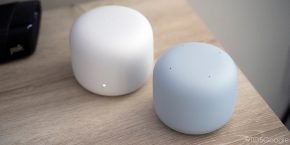
Google’s Home Mini smart speaker and Google Wifi systems have been some of the most popular products of their category for the past few years, and now they’ve gotten refreshes. Here are a few details about the Nest Wifi and the Nest Mini that you might have missed, including the latter’s improved touch controls.
Proximity detection is on the Nest Mini
One feature of the Nest Mini we were tracking ahead of its launch was a sort of proximity detection mode. Now that the product has launched, we know what it’s used for. TechCrunch mentions that the Nest Mini will illuminate dots along the sides of the device that tell the user where they can touch the device to adjust the volume controls.
Google has fixed the touch controls on Nest Mini
Back on the original Google Home Mini, touch controls were implemented much like the original Google Home. A tap to the top of the device could pause music, start a voice command, or snooze an alarm. Unfortunately, a serious bug resulted in Google disabling that feature entirely.
Luckily, Google has fixed the touch controls on the Nest Mini. Not only can you tap either side of the device to play/pause music, but the touch controls can also be used for alarms and more on Nest Mini. It’s a very minor detail, but one we immediately noticed in our hands-on that customers will undoubtedly appreciate.
You can pair Nest Minis together for stereo sound
Those touch controls should especially come in handy with one of the Nest Mini’s new features. Just like on Google Home Max, Google is making it possible to pair two Nest Mini speakers together to be used for stereo sound, as Variety details:
Another big boon for music lovers is the ability to pair two Nest Minis for stereo sound. Previously, Google only allowed this type of functionality for its high-end Home Max speaker. Now, consumers can get true stereo sound for less than $100. With that feature, Google is effectively catching up with Amazon’s smart speakers, which has been allowing stereo pairing for its $50 Echo Dot for some time.
‘Dynamic Volume Adjustment’ can automatically raise or lower the volume
Google’s Nest Mini also has a smart trick with the ability to adjust the volume based on its surroundings. If the ambient noise gets louder while you’re listening to your music, the Nest Mini can also get louder to compensate, as TechCrunch mentions:
Another interesting tidbit that didn’t get a lot of mention at today’s event is dynamic volume adjustment, which adjusts the sound based on background noise. It’s similar to the feature the company teased with today’s Pixel Buds reveal and could come in handy if you happen to live or work in a loud environment. Take that, neighbors.
Why Google didn’t use Wi-Fi 6
Shifting over to the new Nest Wifi, the biggest question about the product by far is why Google didn’t adopt Wi-Fi 6 in the product. It’s a hardware limitation of the product that it doesn’t support the new standard, and for a product that isn’t often replaced, users are understandably curious.

Essentially, the reasoning comes down to cost. Google explained to VentureBeat that Wi-Fi 5 is less expensive, in turn making the product itself more affordable, and most consumers aren’t ready for the new technology anyway. Some new devices, such as Apple’s latest iPhones, do support Wi-Fi 6, but the vast majority of products don’t. For the time being, the addition of Wi-Fi 6 would have made Nest Wifi more expensive for essentially no reason.
Chan [admitted] that a number of Wi-Fi 6 routers already exist in the wild, and noted that it’s a standard that Google is following closely, but he pointed to the balance of cost benefit as the driving factor.
“You do see a lot of routers with Wi-Fi 6 built in, but it charges quite a bit of a premium in order to get that, and in fact, you need to have Wi-Fi 6-compatible other devices in order for it to be a faster experience,” he said. He declined to quote specifics, but said that it would be “hundreds of dollars more expensive” to be Wi-Fi 6-compatible, “for questionable gains in Wi-Fi signal strength.”
“We looked at that ecosystem, and we said hey, maybe one day but not yet. It’s more important that we deliver a ton of value to our users now,” said Chan. “We decided instead to invest in the radios and to ensure that people had great whole-home coverage.” He added that the new two-device mesh Wi-Fi approach Google took with the Nest Wifi Router and Wifi Point offers the same coverage as the original three-pack.
You can share guest network information with a Smart Display
When checking out a Nest Wifi demo at Google’s NYC event, the company also showed me a neat addition coming to smart displays. If you have a product like the Nest Hub Max in your home, you’ll be able to use that product to turn on and show information for your guest network. This should work for Google Wifi eventually as well.

More on Nest:
- Nest Mini hands-on: Barely new in all the best ways [Video]
- Google unveils Nest Wifi Router and ‘Point’ with built-in Assistant speaker
- Google announces Nest Mini with better sound & wall mount, still $49
FTC: We use income earning auto affiliate links. More.



Comments